The Future of Islay – Part Two
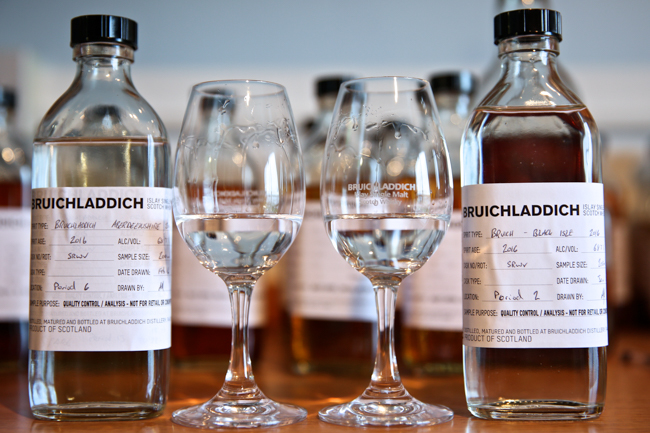
I've seen, smelled, and tasted enough evidence over the last year to finally understand the importance of barley's role in creating the flavor of a single malt whisky. Since sampling ten different "SMASH" beers at Skagit Valley Malting in Washington this past July (made from ten different types of barley), I've got all the proof I need to know that barley-specific malts are clearly the next step in Scotch whisky's evolution as a beverage. But while most of us are just coming around to this realization, one particular distillery on Islay has been exploring the capacity of barley flavor variants for more than a decade. Bruichladdich has not only been testing whiskies made from different species of barley, they've also experimented with various growing locations in Scotland as well as the dynamic of specific vintages. In fact, I can clearly remember the first time I tasted one such whisky from this progressive Hebridian producer: it was Bruichladdich's 2006 Bere barley release, a whisky that absolutely blew me away with its creamy texture and inherently individual character. That eye-opening experience came to market in 2013, but the whisky had originally been distilled seven years prior, clearly indicating that the production team had been keen on exploring barley's capacity for flavor for some time. While a few distilleries like Springbank and Kilchoman have traditionally released local barley editions, none have been as detailed or as dedicated as Bruichladdich in their transparency. Over the last few years, the company has distinctly transitioned from a traditional malt distillery into a serious advocate for more terroir-centric whisky. Part of this metamorphosis has to do with a transition in leadership. This past week I made the trek out to Bruichladdich, both to formally meet the facility's two new directors and take a serious look at their unique vision for the future.

I'm not sure how many folks are aware of the long and intimate relationship between Bruichladdich and K&L, but there's been a deep connection between the two businesses that started well before I took over the spirits department. Not only was K&L the first retailer in the world to bottle and sell a whisky from the post-2001 resurrection distillates, our former whisky expert Susan Purnell actually had her wedding at the distillery and the service was performed by former master distiller and whisky icon Jim McEwan. Susan sent dozens of K&L customers during her tenure over to Islay to learn and work at Bruichladdich's whisky school, and she made damn sure that the first single malts I tasted upon my hiring were from her favorite distillery. I inherited her love of Bruichladdich and tried to continue where Susan left off, visiting Jim on Islay during my first trip to Scotland back in 2011. However, when Bruichladdich sold to Remy Cointreau the following year, I wasn't sure of what to expect. While the immediacy of dealing with an independent distillery changed a bit, I remained close with the company's CEO Simon Coughlin and kept myself abreast of the whisky's evolution through our contact. Over the last four years, Simon's push for more transparency has become the distillery's main focus. Dealing with the adversity of larger distribution and limited stocks, he moved the core range of whiskies from an age statement model over to regionally specific expressions because—like I do now—he believed early on that terroir matters when it comes to whisky. "You've got to come out and visit, David," Simon said to me on the phone a few weeks back. "I really want you to spend some time with Adam, our new distiller, and see how our work is progressing."
Being a fan of Simon, Bruichladdich, and the idea of terroir in anything, I obliged.

Whereas Bruichladdich began as the career culmination of whisky veterans like Coughlin and McEwan, today it's being lead by two forward-thinking youngsters; who better to lead the distillery into the next generation of whisky production than fresh Islay blood? Allan Logan is a fourth generation Islay distillery worker who has been involved in Bruichladdich's production since day one. I spent the first part of my visit with him tasting both aged and unaged distillates from single origin regionally-specific barleys, joking that one indeed smelled "more northern" than the other (as if anyone knew the distinctions between Scottish regional barley flavors). While we shared a few laughs over the feigned pretense, we both agreed there were clear differences in the whiskies—in their infant stage as well as after a few years in wood. There were distinct floral notes and a lighter profile in one malt, while another had a much heavier character and supple richness. I was then introduced to Adam Hannett: a thirty-three year old Islay native who started as an attendant in Bruichladdich's gift shop almost fifteen years ago before becoming the company's current "head" distiller. Two things I loved right off the bat: 1) Adam doesn't refer himself a "master" distiller yet, unlike many craft venturists with far less experience than him; 2) Adam looks almost exactly like my childhood friend Jeff Meanza, so much so in fact that I almost referred to him as Jeff numerous times during our visit. I felt at ease from the moment I met him because of his down-to-earth demeanor and his unpretentious character. "I grew up around here with my friends kicking a soccer ball in the street when there was nothing," Adam said to me as we talked about the changes at Bruichladdich over the years; "Now you have to watch yourself in the road with all the tourists driving around," he added as we headed to the warehouse to sample a few new projects.
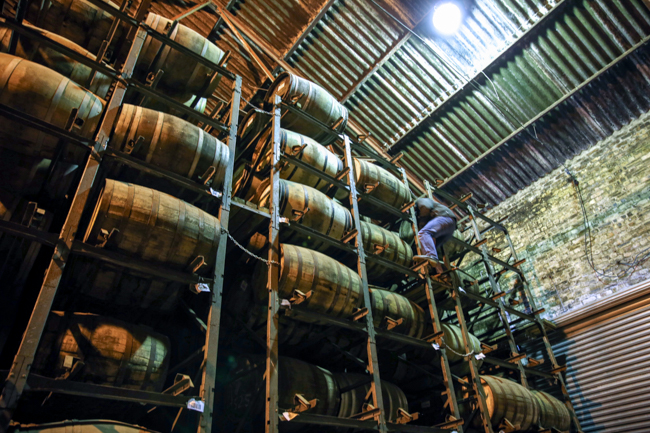
I mentioned to Adam that I was impressed with Allan's presentation of Bruichladdich's regionally-specific whiskies and the clear distinctions he was able to make vis-à-vis their origins. "When people talk about terroir today it often feels as if they're looking to prove what they know rather than clarify why exactly something tastes the way it does," I said, as he proceeded to climb a large rack in search of a specific cask;"It's as if they're searching for the secret no one else knows, but they can't really explain why it's important." Bruichladdich has gone far beyond simply labeling their whiskies as simply "local," choosing to add the vintage, as well as the name and location of the farm where the barley was grown on some of their Islay releases. But while all of of those details definitely play a role in the whisky's inherent flavor, they're not meant to literally explain why it tastes the way it does. No one, as far as I know, has connected the dots at this point yet. "It's not about saying we know something you don't," Adam explained as we continued to discuss the phenomenon; "It's simply about celebrating the community. We're in a position to help the island by way of using local barley. Now the young kids are getting involved in farming, whereas before it was for an older generation." Considering we're approaching a transitional period when the Scotch whisky industry will look to continue its current popularity with a younger generation, creating an early bond with that group's values and interests has never been more important. While the current era of serious whisky connoisseurs may lament the necessary changes that have recently occurred, such as the loss of standard age statements on the label, it could very well be that the next era of drinkers defines its desires by something other than a number.
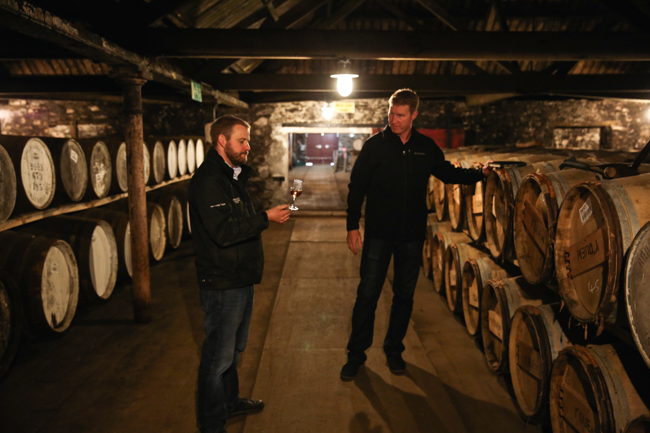
But that's not to say that Bruichladdich is moving away from age statements; on the contrary! After discontinuing their initial new era ten year old shortly after its unveiling, the boys are back with a new version, as well as ten year old Port Charlotte and ten year old Octomore. After sampling the new and improved Bruichladdich 10—a delicious malt that focuses far more on the grain this time around with minimal sherry influence—we took a drive over to the old Lochindaal distillery warehouses where the company keeps its Port Charlotte and Octomore barrels. The improvement that more time in wood displays in the peated whisky's flavor is clear from the initial sip. The profile is rounder, sweeter, and more evolved. In the case of the Octomore, the extra cask time has completely changed the nature of the heavy smoke, moving it more towards an ashy and earthy element on the finish. I was utterly captivated. While Bruichladdich was forced to move away from age statements due to an intermittent supply of mature whisky, purists will be happy to hear the distillery has put that Remy money to good use. While strategically holding back most of their oldest barrels, Bruichladdich simultaneously increased production and will now be in strong supply once the new editions are launched. Keeping their releases at ten years of age is a top priority for the brand, but—if you ask me—numbers won't continue define the distillery's whisky moving forward. Age statements have become security blankets for the old guard. They're a part of whisky's past, a remnant of its former classication, not its immenent future. While I drooled over the twelve year old cask of Port Charlotte available in the gift shop, I have to admit that I was much more interested in the younger 2009 Bere barley vintage release they had on the shelf. It's their improvement and enhancement of distinct barley-driven malts that has me most inspired as of late.
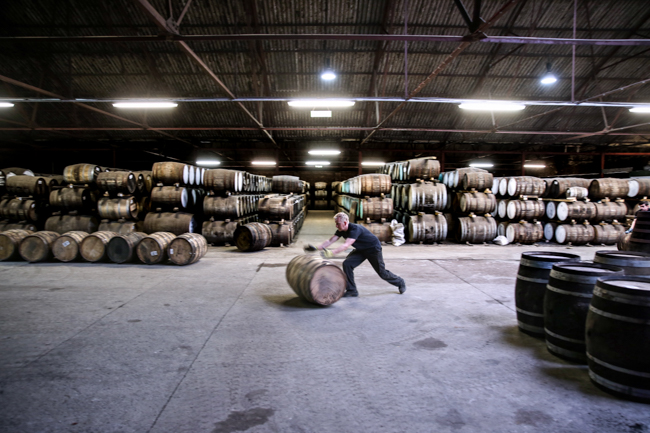
While an adherence to age statements, cask types, and gimmicky marketing stories from old Scottish lore still dominates most Scotch whisky marketing, Bruichladdich has chosen to center its message around the far more difficult discussion of terroir. When you think about it, a sense of place has always been important to the prestige of a product, even in the cases where the place itself had little to do with a unique quality or flavor. It’s the reason why people still continue to buy touristic momentos on vacation, or Bud Light cans with their city’s sports franchise plastered on the side (even though the beer inside each can is exactly the same). It’s the reason people wore Hard Rock Cafe T-shirts back in the eighties—each one identical except for the location of origin. When it comes to marketing and a general consumer interest, the sale of locality has often been more about public proof of experience than genuine individuality ("I was there and I can prove it!"). However, if you can show that terroir isn’t just about showing off, owning bragging rights, or generating a quick ten seconds of Instagram attention—if you can actually present people with a flavor that clearly originates and emirates from one particular spot on this earth—then you’ve really got something. While I’ll continue to enjoy blended whisky and blends of different single malt whiskies, I don’t think there’s a renaissance in the cards for nondescript blends, no matter how much we continue to glamorize the throwback genre. I just don’t see it. As far as I'm concerned, there’s no going back from the new age of transparency. Consumers today want details as to the ingredients and the location of origin from their food, their beer, their wine, and their whisky. Now that the cat is out of the bag there’s no way you’re getting him back inside. The current generation of eaters and drinkers has long spoken about what its willing to embrace: travel, tradition, locality, purity, authenticity, and a sense of place. Nebulous blends with clever marketing need not apply.
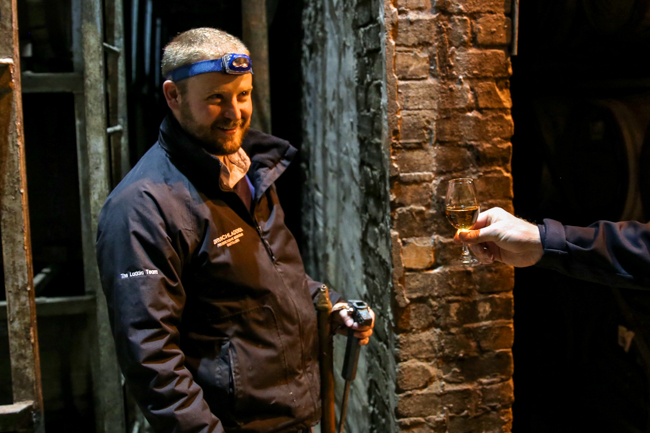
Whisky as an ideal has come to epitomize an enthusiasm for exploration and new experiences. The amount of whisky tourism in Scotland alone these days is unparalleled, but no one drives all the way to Islay to drink a blended whisky or some basic Highland offering. You make the pilgrimage to Islay because you love Islay whisky—the peat, the salt, the earth, and the sea. Whomever can provide the most memorable and moving picture of that wonderful place is going to shape the future of the category. Whomever can speak to the next generation of whisky drinkers in their terms, their language, and within their range of core values, will dominate that genre. I’m betting on Bruichladdich. Almost all of their distillery staff is under the age of thirty-five, the atmosphere is fun and forward-thinking, and the company has a fresh and modern take on whisky. Most importantly, they're continuing to create and inspire.
I've been enamored with Bruichladdich since my first day working at K&L, but I don't think I've ever been as excited about their whisky as I was this week. The future is bright.
-David Driscoll
